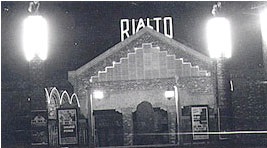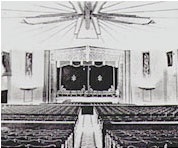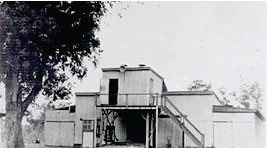Photo (right): Gladesville Theatre, cnr Meriton Street and Wharf Road Gladesville around 1928
Ryde's first exhibitor was bootmaker Charles Starr who ran the Ryde Picture Palace on the corner of Blaxland Road and Tucker Street, next door to his Ryde Boot Palace. It was an open-air theatre with a Wunderlich pressed-metal facade. A few years later a grocer from Drummoyne named Gus Bowe began screening "Gus Bowe's Picture's" in the Kramer Hall on the corner of Wharf Road and Meriton Street Gladesville. This venue was later named the Gladesville Theatre. Around 1915 blacksmith Walter Chick began showing pictures in a tin shed called the Eastwood Picture Palace in Railway Parade Eastwood.
These films were silent. Musicians were engaged to provide accompaniment to the action on the screen. At the Ryde Picture Palace Mr Pope played the piano and Mr Wilson (Starr's partner) played the cornet. At "Chick's Pictures" there was a pianist and a violin player. They kept the audiences pacified during frequent technical breakdowns and fires in the projection room caused by highly flammable nitrate film.
New exhibitors came on the scene in the 1920s. Percy Crane began 'Crane's Pictures' in the Eastwood Masonic Hall in 1924 and late in the same year the Theatre Royal opened in West Ryde on the corner of Anthony Road and West Parade. The Gladesville Palace Theatre De-Luxe opened in early 1926 in Jordan Street, built by prominent local builder James Park.
Serious Business and the Talkies
Picture shows had become serious business in Ryde by the 1920s and a tussle for audience market share emerged between some of the exhibitors. Gus Bowe was at the centre of this competition. In 1922 he bought land in Ryeddale Road West Ryde near Wattle Street. In 1923 he bought land on the corner of Pope and Devlin Streets Ryde and in 1925 he bought land on the corner of Osgathorpe and Victoria Roads Gladesville. He built on the West Ryde land but exhibited there only briefly. Then he engaged architects C Reynolds Winter to design the Victoria Theatre on his Gladesville land and this cinema opened in April 1926. Bowe was also showing pictures in the Ryde Town Hall and still screening at the Gladesville Theatre at this time.
 In the meantime James Park bought land on the corner of Argyle Avenue and Blaxland Road Ryde where he built another theatre which he called the Palace, not so 'de-luxe' as his Gladesville venture. He sold this theatre soon after completion in early 1926 to Henry Thomson of Coogee, owner of the West Ryde Theatre Royal. Thomson later equipped the Palace with sound-on-disc to accompany film and renamed this cinema the Ritz. He had negotiated a financial arrangement with Gus Bowe whereby Bowe agreed to retire as an exhibitor from Ryde for a certain time.
In the meantime James Park bought land on the corner of Argyle Avenue and Blaxland Road Ryde where he built another theatre which he called the Palace, not so 'de-luxe' as his Gladesville venture. He sold this theatre soon after completion in early 1926 to Henry Thomson of Coogee, owner of the West Ryde Theatre Royal. Thomson later equipped the Palace with sound-on-disc to accompany film and renamed this cinema the Ritz. He had negotiated a financial arrangement with Gus Bowe whereby Bowe agreed to retire as an exhibitor from Ryde for a certain time.
Photo: Rialto Theatre Ryde, 1935
The Gladesville Palace was the first theatre in that suburb to become a 'talkie house' and soon became Gladesville's dominant cinema. The lease had been taken over by Gladesville Theatres Pty Ltd in 1934. This company had bought the Victory from Gus Bowe in 1928 and at the same time took over the lease of the Gladesville Theatre. They retained the licence of the Victory to deter competition but kept the venue closed.
Plush Seats, Prosceniums and 'The Shack'
In 1927 Percy Crane moved his pictures from the Masonic Hall to a grand new cinema in Rowe Street called the Duke of York Theatre. It was designed by prominent local architects C R Summerhayes & Son and furnished by Bebarfalds Ltd. Crane's motto was "good pictures, good seats, good music, and good personal service". The theatre boasted an orchestra and a Christie organ and spelt the end of Chick's Pictures.
In Ryde, Henry Thomson's Ritz had been destroyed by fire on New Year's eve 1930. Although Thomson soon announced plans to rebuild, Gus Bowe seized the opportunity to re-enter the industry. He built Ryde's most architecturally ambitious cinema on the land he owned near the tram terminus. This theatre, designed by architects McCredie & Evans, was called the Rialto and opened in December 1932. The exterior brickwork incorporated reds, greens, whites and orange and the concrete roofing tiles were blue and green. Large columns topped with gargoyles flanked the floodlit entrance and a second row of gates were topped with seahorses. The interior of the theatre also boasted unusual decorative features as well as state of the art seating and sound.

In 1931 both the Duke of York and the Theatre Royal introduced the latest sound-on-film technology. Improvements in lighting, proscenium decor, plush seating and carpeting continued to be made throughout the decade in these theatres as well as the Rialto and the Gladesville Palace. These innovations, together with refreshment sellers, uniformed usherettes and managers in evening dress, all combined to create the special atmosphere that was at the heart of the cinema-visiting experience in those years.
Photo (right): Interior of the Rialto Theatre
Meanwhile, in January 1938, North Ryde got its first licensed cinema, the Khartoum. From the beginning the Khartoum was different from its better-upholstered rivals. It was open-air, built mostly of corrugated iron and featured wood-chopping contests in the interval. Whereas the Duke of York was 'scientifically heated', at the Khartoum (or 'the shack' as it was fondly known by its patrons) heating was provided by 44 gallon drums filled with paper, wood, coke and coal.
One challenge to the Khartoum appeared in 1956 in the form of the North Ryde Drive-In in Waterloo Road but the greater threat to cinemas everywhere in 1956 was the arrival of television. One by one Ryde's cinemas closed: the Theatre Royal in 1958, the Rialto in 1960, the Khartoum in 1966 and the Palace in 1967. In Eastwood the former Duke of York had become the Odeon and managed to hang on until January 1973. In 1986 the North Ryde Drive-In closed.
 Today the only buildings surviving from the hey-day of Ryde cinemas are the former Gladesville Theatre, the ill-fated Ritz and the erstwhile Victory.
Today the only buildings surviving from the hey-day of Ryde cinemas are the former Gladesville Theatre, the ill-fated Ritz and the erstwhile Victory.
Photo (right): Khartoum open-air picture theatre, North Ryde. Built in 1938.
Written by Megan Martin (former Local Studies Librarian) and David Wilson for Ryde Library Services. April 1999.